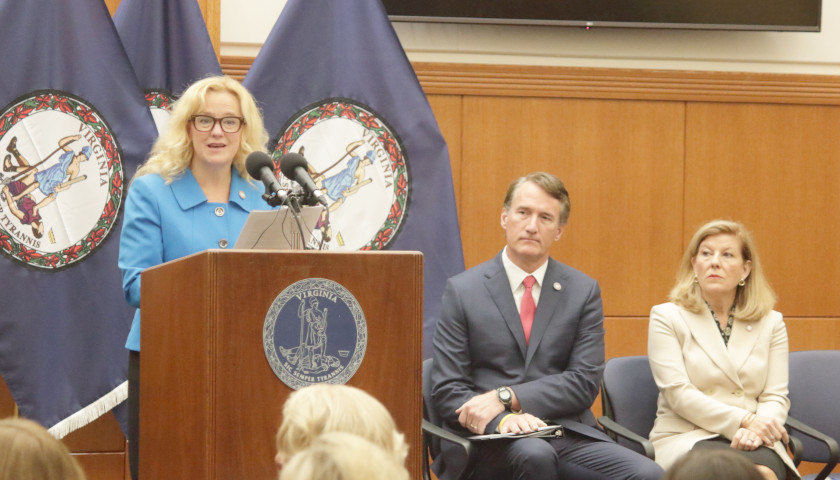RICHMOND, Virginia – Virginia’s scores on the National Assessment of Educational Progress (NAEP) are “catastrophic,” Governor Glenn Youngkin said in a press conference Monday morning, hours after the NAEP scores were released. Nationally, U.S. Secretary of Education Miguel Cardona said in a press release the scores are “appalling.” Virginia’s Republican education administration blamed the commonwealth’s scores on Democratic policy under previous administrations predating COVID-19, while Cardona said the national results are “a reminder of the impact that this pandemic has had on our learners.”
“Today’s data release is a clear and heart-wrenching statement that Virginia is failing her students,” Virginia Secretary of Education Aimee Guidera said at the conference, and said the results are not a surprise. “Recent data from the ACT, SOLs [Standards of Learning], from the PALS data, and today’s catastrophic decline in Virginia’s NAEP scores are a predictable outcome of the decade-long systemic dismantling of a foundational commitment to excellence in education.”
The report found that 32 percent of Virginia’s fourth graders are at or above proficient, the same as the national average, but down from 43 percent in 2013, 2015, and 2017, years when the national average was 34 and 35 percent. Thirty-eight percent of Virginia fourth graders are proficient or above in math, down from 50 percent in 2017 and 48 percent in 2019; in the 2022 assessment the national average is 35 percent.
“After decades of performing well above the national average, our fourth graders are now at the national mean,” Superintendent of Public Instruction Jillian Balow said while discussing the reading scores.
“This massive learning loss cannot be blamed solely on the pandemic because nearly half of the learning loss occurred before anyone in this room ever heard of COVID-19,” she said.
Balow’s presentation highlights the 2017 introduction of new standards of accreditation, and the 2020 introduction of new reading SOL cut scores are the lowest as coinciding with the decline in reading performance. It highlights new 2019 SOL cut scores as coinciding with the beginning of a decline in math performance.
“In 2017 and again in 2019, policymakers didn’t just take their foot off the gas. They put on the brakes on high expectations and they lowered the bar for Virginia education,” she said.
NAEP also assesses eighth-grade performance on math and reading. Thirty-one percent of Virginia eighth graders scored proficient or above in reading, down from 37 percent in 2017, and 31 percent scored proficient or above in math, down from 40 percent in 2017.
Youngkin called for action steps including higher expectations, a partnership with Khan Academy and online tutoring platform Schoolhouse for supplemental tutoring, and an easier pipeline for teachers to enter the classroom. He called on school districts to use federal COVID relief to help students. He also called for community members to volunteer.
“This is not something that state government is going to resolve on our own, or local government is going to resolve on their own. We need everyone,” Youngkin said.
He said people can volunteer to tutor through Schoolhouse (schoolhouse.world) or call their local school district to get involved as local tutors, and said anyone who is considering becoming a teacher should visit Virginia’s Become a Teacher website.
“When we see these numbers today, just like the numbers that we’ve seen flowing from tests taken over the course of the last three years, it upsets us and this should be a call to action. This is a moment for us to recognize that the path we’re on is the right path. We just have to run faster. Our kids don’t have time,” he said.
Nationally, NAEP reports that from 2019 to 2022, fourth-grade mathematics scores declined across the country in 43 states and jurisdictions, and none increased. Eighth-grade mathematics declined in 51 states/jurisdictions, with none increasing. In fourth-grade reading, 30 states and jurisdictions decreased, with none increasing, and in eighth grade, 33 states and jurisdictions decreased with the Department of Defense Education Activity the only jurisdiction with increased performance.
“This once-in-a-generation virus upended our country in so many ways –– and our students cannot be the ones who sacrifice most now or in the long run. We must treat the task of catching our children up in reading and math with the urgency this moment demands,” U.S. Secretary Cardona said in a press release.
He said the states that didn’t see losses are hopeful signs, and said that COVID-19 relief funds are helping schools address learning loss. He also touted the work done by the Biden administration for its work to provide resources for schools through the American Rescue Plan (ARP), and credited the administration with getting schools 100 percent open for in-person learning while criticizing Republicans for voting against ARP.
“Schools across the country—in red and blue states—are using ARP funds to invest in high-impact strategies that we know result in learning gains and support students’ mental health, including hiring more teachers, tutors, and mental health professionals and expanding after-school programs,” he said.
Cardona said his department would provide more tools to help educators use ARP funds to address learning losses, would provide more information on tools to advance math and literacy learning, and that the department already published a checklist to make sure parents have the tools they need to ensure their children are getting the support they deserve using federal relief dollars.”
“The time is now. This is our moment. It’s up to all of us to raise the bar in education,” Cardona said.
– – –
Eric Burk is a reporter at The Virginia Star and The Star News Network. Email tips to [email protected].
Photos by Eric Burk.





